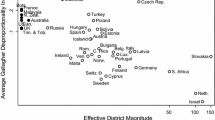Abstract
A policy is the outcome of negotiations between two three-party parliamentary states. An election in jurisdiction A determines the composition of the legislature that selects a representative to negotiate an intergovernmental policy agreement with the representative from the legislature of jurisdiction B. Negotiations are modeled using Nash (Econometrica 18(2):155–162, 1950) bargaining framework. With heterogeneous parties, agreements and electoral outcomes depend on the concavity of the utility functions of negotiators and on the relative location of their ideal policies, i.e., depend on the negotiators relative willingness to compromise. Agreements between the bargainers may not follow the ordering of the parties’ ideal policies. An electoral outcome where support for the center party comes from extreme voters may emerge.
Similar content being viewed by others
References
Alesina A, Rosenthal H (1995) Partisan politics, divided government, and the economy. Cambridge University Press, Cambridge
Alesina A, Rosenthal H (1996) A theory of divided government. Econometrica 64: 1311–1341
Austen-Smith D (2000) Redistributing income under proportional representation. J Polit Econ 108(6): 1235–1269
Austen-Smith D, Banks J (1988) Elections, coalitions, and legislative outcomes. Am Polit Sci Rev 82(2): 405–422
Breton A (1996) Competitive governments: an economic theory of politics and public finance. Cambridge University Press, Cambridge
Binmore K, Rubinstein A, Wolinsky A (1986) The nash bargaining solution in economic modeling. Rand J Econ 17: 176–188
Cho S, Duggan J (2003) Uniqueness of stationary equilibria in a one-dimensional model of bargaining. J Econ Theory 113(1): 118–130
Coate S, Knight B (2007) Socially optimal districting: a theoretical and empirical exploration. Q J Econ 122(4): 1409–1471
Crémer J, Palfrey TR (2000) Federal mandates by popular demand. J Polit Econ 108(5): 905–927
Crémer J, Palfrey TR (2002) Federal mandates with local agenda setters. Rev Econ Des 7(3): 279–296
Crémer J, Palfrey TR (2006) An equilibrium voting model of federal standards with externalities. J Public Econ 90: 2091–2106
Cressman R, Gallego M (2009) On the ranking of bilateral bargaining opponents. Math Soc Sci 58(1): 64–83
Curry Bill, Chase Steven (2006) Willing to work with NDP, Harper says. Globe and Mail A4, Toronto
Denzau AT, Mackay RJ (1983) Gatekeeping and monopoly power of committees: an analysis of sincere and sophisticated behavior. Am J Polit Sci 27: 740–761
Diermeier D, Merlo A (2004) An empirical investigation of coalitional bargaining procedures. J Public Econ 88: 783–797
Fiorina M (1996) Divided Government, 2nd Edition. Allyn and Bacon, Boston
Gallagher M, Laver M, Mair P (2005) Representative government in modern europe, 4th edition. McGraw Hill, New York
Greenberg J, Weber S (1985) Multiparty equilibria under proportional representation. Am Polit Sci Rev 79(3): 693–703
Kalai E (1977) Proportional solutions to bargaining situations: interpersonal utility comparisons. Econometrica 45: 1623–1630
Kalai E, Smorodinsky M (1975) Other solutions to Nash’s bargaining problem. Econometrica 43: 513–518
Kannai Y (1977) Concavifiability and construction of concave utility functions. J Math Econ 4: 1–56
Kedar O (2005) When moderate voters prefer extreme parties: policy balancing in parliamentary elections. Am Polit Sci Rev 99(2): 185–199
Kihlstrom RE, Roth A, Schmeidler D (1981) Rish Aversion and Nash’s solution to the bargaining problem. In: Moeschlin O, Pallaschke D (eds) Game theory and mathematical economics. Amsterdam, North Holland, pp 65–71
Milgrom P, Shannon C (1994) Monotone comparative statics. Econometrica 62(1): 157–180
Moravcsik A (1991) Negotiating the single European act: national interests and conventional statecraft in the European community. Int Organ 45: 19–56
Moravcsik A (1993) Preferences and power in the European community: a liberal intergovernmentalist approach. J Common Mark Stud 31(4): 473–524
Moravcsik A, Nicolaïdis K (1999) Explaining the treaty of Amsterdam: interest, influence and institutions. J Common Mark Stud 37(1): 59–85
Nash JF (1950) The bargaining problem. Econometrica 18(2): 155–162
Patty JW, Snyder JM Jr, Ting MM (2009) Two’s company, three’s an equilibrium: strategic voting and multicandidate elections quarterly. J Polit Sci 4(3): 251–278
Perles MA, Maschler M (1981) A supper additive solution for the Nash bargaining game. Int J Game Theory 10: 163–193
Persson T, Tabellini G (1996) Federal fiscal constitutions: risk sharing and redistribution. J Polit Econ 104(5): 979–1009
Peters H (1992) A criterion for comparing strength of preferences with an application to bargaining. Oper Res 40(5): 1018–1022
Roth A (1979) Axiomatic models of bargaining. Springer, Berlin and New York
Romer T, Rosenthal H (1978) Political resource allocation, controlled agenda, and the status quo. Public Choice 33: 27–44
Saporiti A, Tohmé F (2006) Single-crossing, strategic voting and the median choice rule. Soc Choice Welf 26(2): 363–383
Thomson W (1994) Cooperative models of bargaining. In: Auman RJ, Hart S (eds) Handbook of game theory. Elsevier Science, Amsterdam, pp 1237–1284
Thomson W (2009) Bargaining and the theory of cooperative games: John Nash and beyond. Rochester Center for Economic Research Working Paper No. 554, September 2009
Whalley J (2008) Recent regional agreements: why so many, why so much variance in form, why coming so fast, and where are they headed? World Econ 31(4): 517–532
Author information
Authors and Affiliations
Corresponding author
Rights and permissions
About this article
Cite this article
Gallego, M.E., Scoones, D. Intergovernmental negotiation, willingness to compromise, and voter preference reversals. Soc Choice Welf 36, 591–610 (2011). https://doi.org/10.1007/s00355-010-0511-4
Published:
Issue Date:
DOI: https://doi.org/10.1007/s00355-010-0511-4




